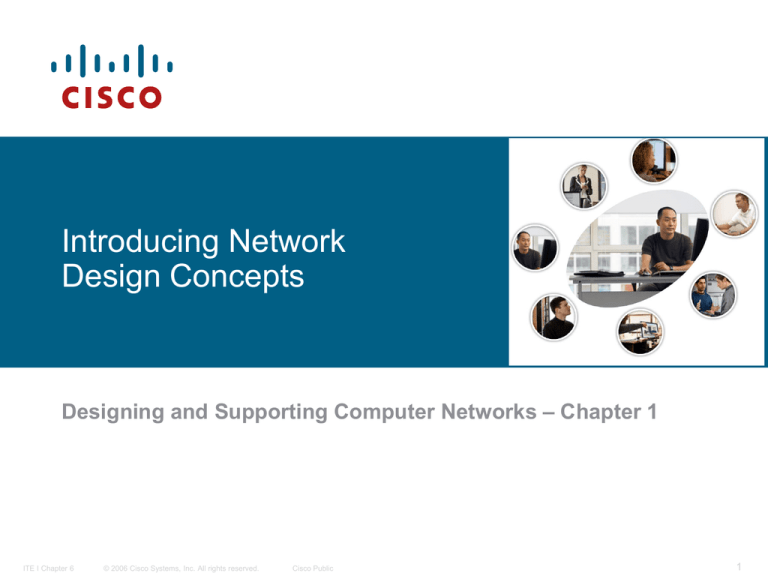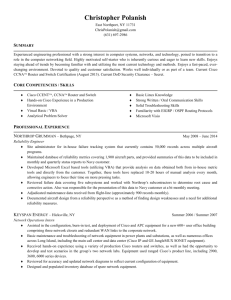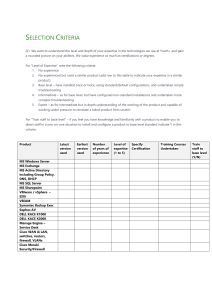
Introducing Network
Design Concepts
Designing and Supporting Computer Networks – Chapter 1
ITE I Chapter 6
© 2006 Cisco Systems, Inc. All rights reserved.
Cisco Public
1
Objectives
Explain how a hierarchical network design creates a stable,
reliable, scalable network
Explain what factors need to be considered when the Core Layer
of a network is designed and implemented
Explain which factors need to be considered when the
Distribution Layer of a network is designed and implemented
Explain which factors need to be considered when the Access
Layer of a network is designed and implemented
Describe the benefits and security implications of creating server
farms
Describe the considerations of an implementation of a wireless
network design
Describe the factors that affect the implementation of VPNs,
including how remote workers can be supported
ITE 1 Chapter 6
© 2006 Cisco Systems, Inc. All rights reserved.
Cisco Public
2
Explain How a Hierarchical Network Design
Creates a Stable, Reliable, Scalable Network
Network requirements:
Ease of management
Fast recovery
Application response time
Fast troubleshooting
ITE 1 Chapter 6
© 2006 Cisco Systems, Inc. All rights reserved.
Cisco Public
3
Explain How a Hierarchical Network Design
Creates a Stable, Reliable, Scalable Network
Four fundamental network design goals:
Scalability
Availability
Security
Manageability
ITE 1 Chapter 6
© 2006 Cisco Systems, Inc. All rights reserved.
Cisco Public
4
Explain How a Hierarchical Network Design
Creates a Stable, Reliable, Scalable Network
Core Layer: connects Distribution Layer devices
Distribution Layer: interconnects smaller LANs
Access Layer: provides connections for hosts and end
devices
ITE 1 Chapter 6
© 2006 Cisco Systems, Inc. All rights reserved.
Cisco Public
5
Explain How a Hierarchical Network Design
Creates a Stable, Reliable, Scalable Network
Subdividing the three-layer model into modular areas:
Enterprise campus
Server farm
Enterprise edge
ITE 1 Chapter 6
© 2006 Cisco Systems, Inc. All rights reserved.
Cisco Public
6
Explain How a Hierarchical Network Design
Creates a Stable, Reliable, Scalable Network
Steps in network design projects:
Identify the network requirements
Characterize the existing network
Design the network topology and solutions
ITE 1 Chapter 6
© 2006 Cisco Systems, Inc. All rights reserved.
Cisco Public
7
Explain what Factors Need to be Considered
when Designing the Network Core Layer
Network backbone
Goals of the Core Layer
Provide 100% uptime
Maximize throughput
Facilitate network growth
ITE 1 Chapter 6
© 2006 Cisco Systems, Inc. All rights reserved.
Cisco Public
8
Explain what Factors Need to be Considered
when Designing the Network Core Layer
Combining routing and switching in the same device
Redundancy and load balancing
High-speed and aggregate links
Quick convergence
ITE 1 Chapter 6
© 2006 Cisco Systems, Inc. All rights reserved.
Cisco Public
9
Explain what Factors Need to be Considered
when Designing the Network Core Layer
Full mesh topology
Partial mesh topology
Failure prevention
Reducing human error
ITE 1 Chapter 6
© 2006 Cisco Systems, Inc. All rights reserved.
Cisco Public
10
Explain which Factors Need to be Considered when
Designing the Distribution Layer of a Network
Filtering and managing traffic flow
Access control policies
Route summarization
Isolating Core Layer from Access Layer failures
Routing between VLANs
ITE 1 Chapter 6
© 2006 Cisco Systems, Inc. All rights reserved.
Cisco Public
11
Explain which Factors Need to be Considered when
Designing the Distribution Layer of a Network
Explain how redundant links improve network reliability
and stability
ITE 1 Chapter 6
© 2006 Cisco Systems, Inc. All rights reserved.
Cisco Public
12
Explain which Factors Need to be Considered when
Designing the Distribution Layer of a Network
Explain how ACLs filter traffic for security and traffic
management
ITE 1 Chapter 6
© 2006 Cisco Systems, Inc. All rights reserved.
Cisco Public
13
Explain which Factors Need to be Considered when
Designing the Distribution Layer of a Network
Explain the concept of route summarization and
describe how it is implemented at the Distribution Layer
of the network
ITE 1 Chapter 6
© 2006 Cisco Systems, Inc. All rights reserved.
Cisco Public
14
Explain which Factors Need to be Considered
when Designing the Access Layer of a Network
Physical location of equipment
Wiring closets
Converged networking
Availability
ITE 1 Chapter 6
© 2006 Cisco Systems, Inc. All rights reserved.
Cisco Public
15
Explain which Factors Need to be Considered
when Designing the Access Layer of a Network
Naming structures
VLAN architecture
Traffic patterns
Prioritization strategies
ITE 1 Chapter 6
© 2006 Cisco Systems, Inc. All rights reserved.
Cisco Public
16
Explain which Factors Need to be Considered
when Designing the Access Layer of a Network
Star topologies
ITE 1 Chapter 6
© 2006 Cisco Systems, Inc. All rights reserved.
Cisco Public
17
Explain which Factors Need to be Considered
when Designing the Access Layer of a Network
Functions of VLANs:
Separate and classify traffic
Control broadcasts
Contain VLANs within a single wiring closet
ITE 1 Chapter 6
© 2006 Cisco Systems, Inc. All rights reserved.
Cisco Public
18
Explain which Factors Need to be Considered
when Designing the Access Layer of a Network
QoS at the network edge:
Classification
Assigned priority
ITE 1 Chapter 6
© 2006 Cisco Systems, Inc. All rights reserved.
Cisco Public
19
Explain which Factors Need to be Considered
when Designing the Access Layer of a Network
Security risks at the network edge:
Authentication
Wireless security
ITE 1 Chapter 6
© 2006 Cisco Systems, Inc. All rights reserved.
Cisco Public
20
Explain which Factors Need to be Considered
when Designing the Access Layer of a Network
Security measures at the Access Layer:
Physical security
Strong passwords
SSH
Disabling unused ports
Security policy
ITE 1 Chapter 6
© 2006 Cisco Systems, Inc. All rights reserved.
Cisco Public
21
Describe the Benefits and Security
Implications of Creating Server Farms
Defined entry and exit points for network traffic
Redundant, high-capacity links
Load balancing and failover
Lower cost of providing services
ITE 1 Chapter 6
© 2006 Cisco Systems, Inc. All rights reserved.
Cisco Public
22
Describe the Benefits and Security
Implications of Creating Server Farms
Firewalls
LAN switch security features
Intrusion and prevention systems
Load balancers
Network analysis and management devices
DMZs
ITE 1 Chapter 6
© 2006 Cisco Systems, Inc. All rights reserved.
Cisco Public
23
Describe the Benefits and Security
Implications of Creating Server Farms
Building in redundancy for high availability
Virtualization
ITE 1 Chapter 6
© 2006 Cisco Systems, Inc. All rights reserved.
Cisco Public
24
Describe the Considerations of an Implementation
of a Wireless Network Design
Customer requirements:
Roaming
Authentication
Services and applications
Encryption
Coverage and number of users
ITE 1 Chapter 6
© 2006 Cisco Systems, Inc. All rights reserved.
Cisco Public
25
Describe the Considerations of an Implementation
of a Wireless Network Design
Physical WLAN design
Site survey
Logical WLAN design
Open guest access vs. secured employee access
ITE 1 Chapter 6
© 2006 Cisco Systems, Inc. All rights reserved.
Cisco Public
26
Describe the Factors that Affect the
Implementation of VPNs
Cost of bandwidth
QoS
Security
Remote access
ITE 1 Chapter 6
© 2006 Cisco Systems, Inc. All rights reserved.
Cisco Public
27
Describe the Factors that Affect the
Implementation of VPNs
Interconnection options:
Traditional WAN technologies
Newer WAN technologies
ITE 1 Chapter 6
© 2006 Cisco Systems, Inc. All rights reserved.
Cisco Public
28
Describe the Factors that Affect the
Implementation of VPNs
Explain ways to provide redundant connectivity to
remote sites
ITE 1 Chapter 6
© 2006 Cisco Systems, Inc. All rights reserved.
Cisco Public
29
Summary
The four fundamental technical requirements of
network design are scalability, availability, security and
manageability.
Network projects involve identifying the requirements,
characterizing the existing network, and designing the
network topology and solutions.
Redundancy at the Core Layer keeps the network
functioning even when a device or link fails.
Routing efficiency at the Distribution Layer isolates the
Core from Access Layer failures.
Using VLANs and IP subnets is the most common way
to segregate user groups and traffic within the Access
Layer.
ITE 1 Chapter 6
© 2006 Cisco Systems, Inc. All rights reserved.
Cisco Public
30
ITE 1 Chapter 6
© 2006 Cisco Systems, Inc. All rights reserved.
Cisco Public
31




